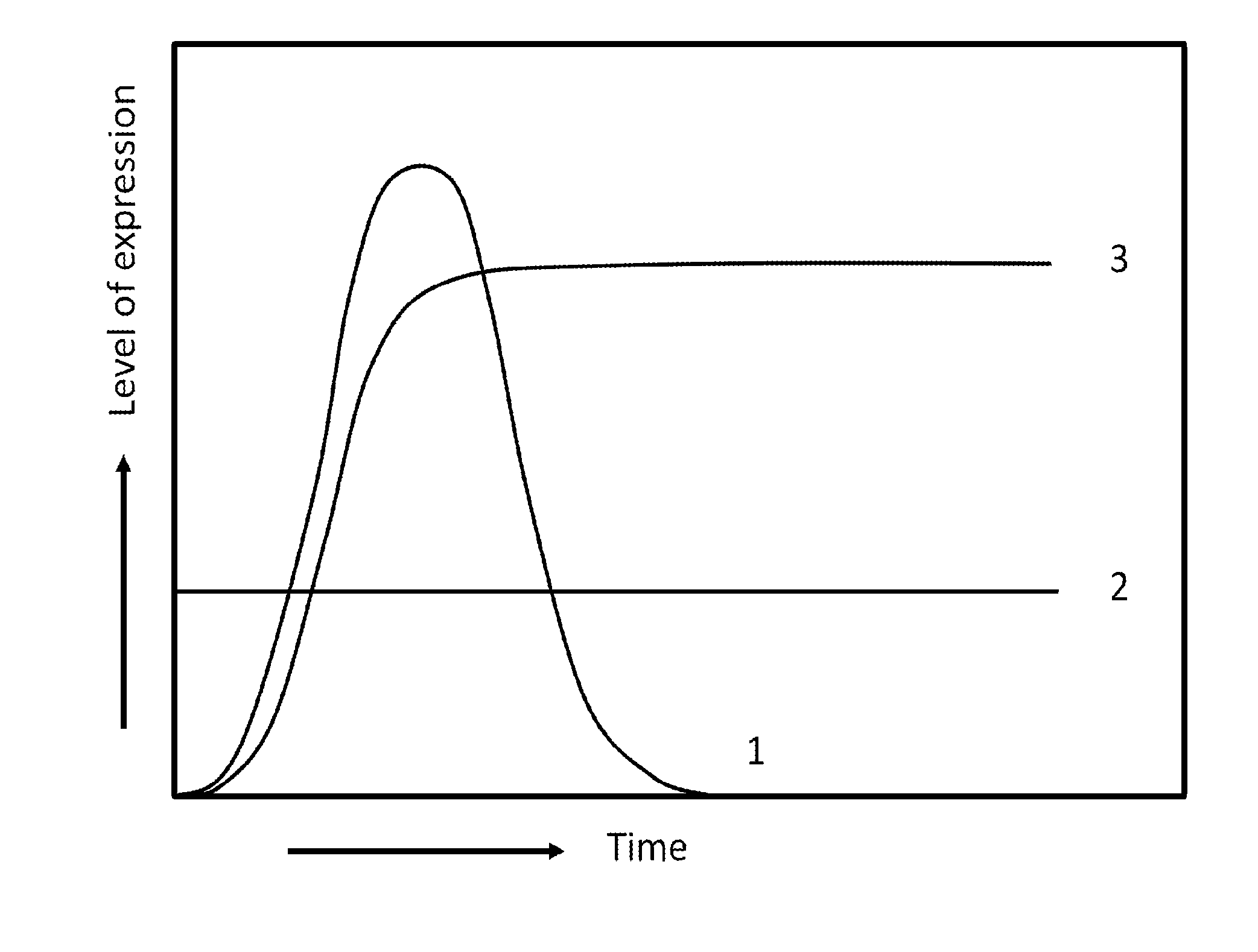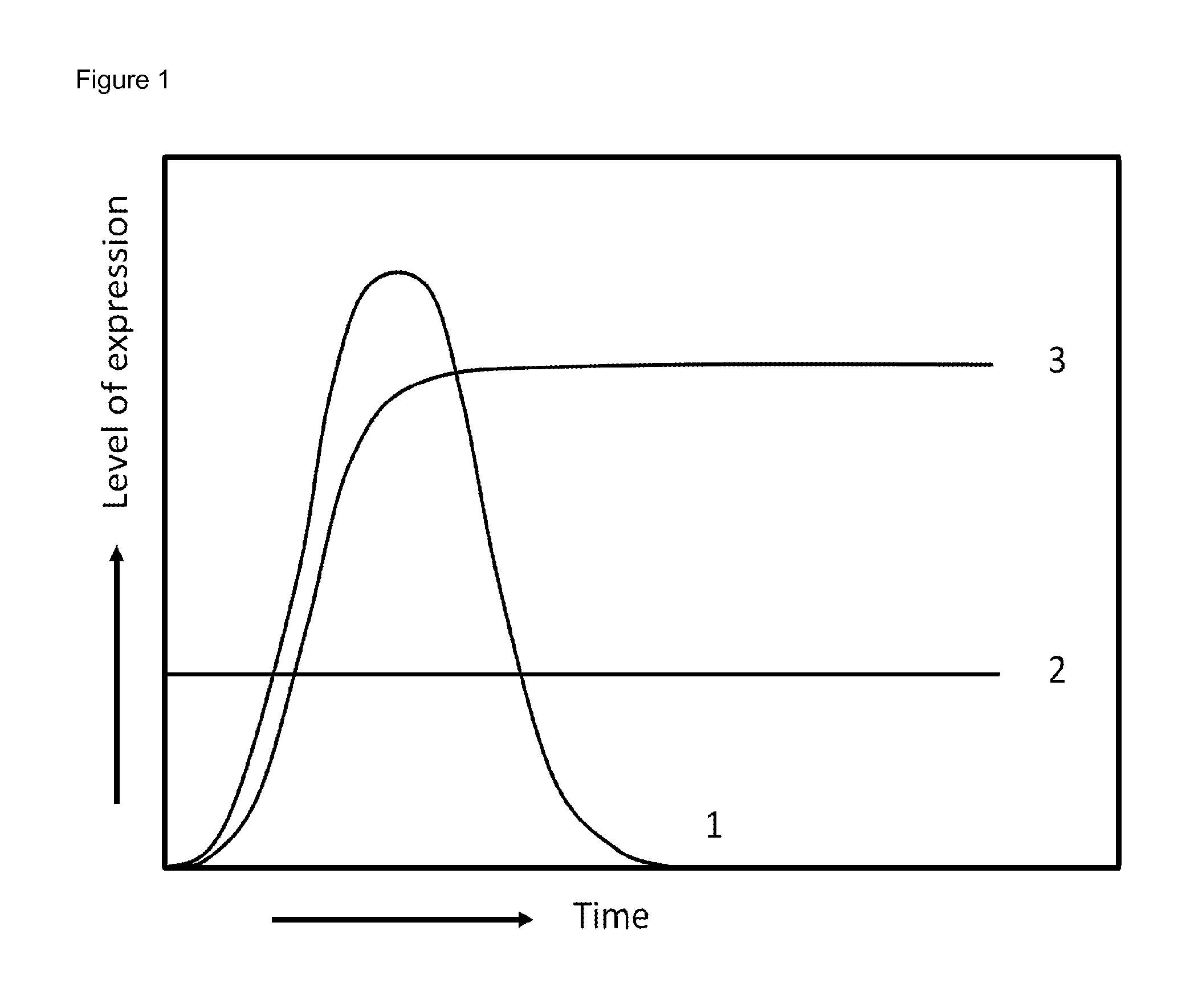Method for the expression of a recombinant protein in a mammalian cell
a technology of recombinant protein and mammalian cell, which is applied in the field of methods for the production of recombinant protein in mammalian cells, can solve the problems of unattractive commercial application of rna virus-derived replicons, high cost and time-consuming process for cell clone selection,
- Summary
- Abstract
- Description
- Claims
- Application Information
AI Technical Summary
Benefits of technology
Problems solved by technology
Method used
Image
Examples
example 1
Construction of an Expression Plasmid Encoding the SV40 Large T Antigen
[0083]A synthetic multiple cloning site (MCS) was designed containing restriction sites for NotI, PacI, SbfI, PmeI, AscI and ClaI. Two oligonucleotides were designed WdV436: 5′-GCCGCTTTATTAATTAAGCCCTGCAGGTTGTTTAAACTTGGCGCGCCTTAT-3′ (SEQ ID NO: 1) and WdV437: 5′-CGAAATAATTAATTCGGGACGTCCAACAAATTTGAACCGCGCGGAATAGC-3′. (SEQ ID NO 2). Both oligonucleotides WdV436 and WdV437 were annealed to each other and ligated into pBluescript SK- (Promega), yielding the recombinant plasmid pAM007.
[0084]Two oligonucleotides were designed to introduce an additional NotI restriction site WdV452: 5′-CGGCGGCCGCGTAC-3′ (SEQ ID NO: 3) and WdV453: 5′-GCGGCCGC-3′. Both oligonucleotides were annealed and ligated into pAM007, yielding the recombinant vector pAM008.
[0085]The expression vector pLenti6.3 / V5DEST_verA (Invitrogen) was used as a template for cloning of the cytomegalovirus immediate early (CMVie) promoter using PCR. Two oligonucleo...
example 2
Generation of a Vero Producer Cell Line
[0099]Vero cells (Sigma-Aldrich order number: 88020401) were propagated and adapted to serum free culture DMEM medium (Invitrogen, product code: 41966-052). Adaptation to serum free conditions was performed by gradually reducing fetal bovine serum from 8, 6, 4, 2 and 0% in the medium each passage. From then the Vero-Serum Free (Vero-SF) cells were cultured in OptiPro SFM medium (Invitrogen) containing 2% L-glutamine at 37° C. and 5% CO2.
[0100]Vero-SF cells were transfected with pAM001 DNA using the transfection agent Exgen 500 (Fermentas, product code: R0511) according to the suppliers prescriptions. The transfected Vero-SF cells were subsequently selected for integration of the SV40 large T expression gene cassette into the chromosomal DNA by adding 2 μg / ml puromycine to the cell culture medium. Surviving colonies were isolated and propagated in OptiPro SFM medium containing 2 μg / ml puromycine and 2% L-glutamine. Puromycin-resistant cells were...
example 3
Construction of SV40-Based Replicon Plasmids
[0102]Six oligonucleotides were designed: WdV101: 5′-CCGCTCGAGTTGCGGCCGCTGTGCCTTCTAGTTGCCAGCCATC-3′ (SEQ ID NO: 18, containing a XhoI and a NotI restriction site) and WdV102: 5′-GGTACCATAGAGCCCACCGCATCCCCAGCATGCC-3′ (SEQ ID No.19) (containing a KpnI restriction site) and WdV103: 5′-GGCCGCTTTATTAATTAAGCCCTGCAGGTTGTTTAAACTTGGCGC GCCTTAT-3′(SEQ ID NO: 20, containing from 5′ to 3′ subsequently a NotI sticky restriction site, a PadI, SbfI, PmeI and an AscI intact restriction site and a ClaI sticky restriction site) and WdV104: 5′-CGATAAGGCGCGCCAAGTTTAAACAACCTGCAGGGCTTAATTAAT AAAGC-3′ (SEQ ID No. 21) (contains from 3′ to 5′ subsequently a NotI sticky restriction site, a PadI, SbfI, PmeI and an AscI intact restriction site and a ClaI sticky restriction site) and WdV105: 5′-CGGGATCCAGACATGATAAGATACATTG-3′ (SEQ ID NO: 22, containing a BamHI restriction site) and WdV106: 5′-ATAGTTTAGCGGCCGCAACTTGTTTATTGCAGCTTATAATGG-3′ (SEQ ID NO: 23, containing a N...
PUM
| Property | Measurement | Unit |
|---|---|---|
| cell densities | aaaaa | aaaaa |
| time | aaaaa | aaaaa |
| of time | aaaaa | aaaaa |
Abstract
Description
Claims
Application Information
 Login to View More
Login to View More - R&D
- Intellectual Property
- Life Sciences
- Materials
- Tech Scout
- Unparalleled Data Quality
- Higher Quality Content
- 60% Fewer Hallucinations
Browse by: Latest US Patents, China's latest patents, Technical Efficacy Thesaurus, Application Domain, Technology Topic, Popular Technical Reports.
© 2025 PatSnap. All rights reserved.Legal|Privacy policy|Modern Slavery Act Transparency Statement|Sitemap|About US| Contact US: help@patsnap.com


